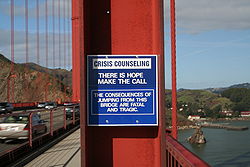- Crisis hotline
-
As a suicide prevention initiative, this sign on the Golden Gate Bridge promotes a special telephone that connects to a crisis hotline.

Suicide 
Social aspects Legislation ·
Philosophy
Religious views · Euthanasia
Right to die · Benevolent suicideSuicide crisis Assessment of risk · Crisis hotline · Intervention · Prevention · Suicide watch Suicide types Assisted · Copycat · Cult · Familicide · Forced · Honor · Internet · Mass · Murder–suicide · Parasuicide · Suicide attack · By cop · Pact Epidemiology Gender · Suicide rate History Suicide in antiquity · List of suicides · Suicide methods (Hanging, London Underground) Related phenomena Ideation · Self-harm · Suicide note · Locations · Failed suicide attempt By country Canada · China · France · India · Japan · Pakistan · South Korea · United States Rates List of countries by suicide rate
List of OECD countries by suicide rateA crisis hotline is a phone number people can call to get immediate emergency telephone counseling, usually by trained volunteers. Such hotlines have existed in most major cities of the United States at least since the mid-1970s. Initially set up to help those contemplating suicide, many have expanded their mandate to deal more generally with emotional crises. Similar hotlines operate to help people in other circumstances, including rape victims, bullying victims, runaway children, and people who identify as gay, lesbian, bisexual, transgender, or intersex.
Contents
History
Such services began in 1953, when Chad Varah, an English vicar, founded The Samaritans service, which soon established branches throughout the United Kingdom. The first Samaritans branch in the United States was established in Boston in 1974.[1] In addition to Boston, there are currently Samaritan branches in Falmouth (serving the Cape Cod and Islands area),[2] the Merrimack Valley,[3] the Fall River/New Bedford area.[4] Outside of Massachusetts, there are branches in New York City,[5] Providence,[6] Hartford,[7] Albany,[8] and Keene, New Hampshire.[9]
In the United States, the Los Angeles Suicide Prevention Center was founded in 1958 and was the first in the country to provide a 24-hour suicide prevention crisis line and use community volunteers in providing hotline service.[10] San Francisco Suicide Prevention[11] started a hotline "Call Bruce" in 1962. A similar service, Lifeline, was established in Australia in 1963. A totally volunteer-run crisis hotline, Samaritans Tasmania, originally called Launceston Lifelink, then Lifelink Samaritans was established in Tasmania in 1968 by concerned citizens of Launceston, Tasmania who decided to create a phone service based on the principles of the Samaritans. The rationale was that people often become suicidal because they cannot discuss with family and friends their emotional pain. This service provides emotional support 24 hours a day to callers from all over the state of Tasmania and does not have any religious affiliations. The organisation is a member of Befrienders Worldwide and has a "twinning" relationship with Northampton Samaritans in the UK. Samaritans Tasmania is the oldest telephone befriending service in Tasmania and the fourth oldest in Australia and it receives at least 5000 calls a year.
Criticism and logistical issues
One criticism of suicide hotlines in the past was that those who were determined to kill themselves were unlikely to call one. Also, those with social anxiety may not have the emotional resources to do so. Until recently, there was no evidence that the presence of suicide hotlines reduced the incidence of suicide.[12] However, a 2007 study has suggested otherwise,[13] as peoples' thoughts of suicide decreased during a call to a crisis line, and were lessened for several weeks after their call.
Another issue is that crisis hotlines often contact local authorities. The fear of embarrassment from having the police involved can deter many people who would have otherwise called the hotline. Compounding this further, getting police involved can cause a troubled situation at home to become even worse, members of an already dysfunctional family become more irate with the distressed person. Also, being asked for an address can be seen as an immediate violation of trust, leading to even deeper feelings of hopelessness and isolation. However, many crisis lines do not trace calls and will only offer to send medical assistance if the caller asks for it, thus ensuring that callers can use the service without fear of unwanted emergency services involvement. Callers can ask the particular crisis line they're using what their policy is regarding this matter.
Telephone counseling
Some countries regulate the use of the term "counselor". Telephone counseling and Crisis hotlines provide a similar telephone support service, and both usually accept crisis and non-crisis calls.
The term "emotional support helpline" is sometimes used - which does not imply crisis or counselling, and can include email and messaging.
List of crisis hotlines
The Volunteer Emotional Support Helplines (VESH) represents 1200 member centres in 61 countries. It has been formed by
- Befrienders Worldwide[14] (maintained by the Samaritans UK)
- IFOTES - International Federation of Telephone Emergency Services,[15]
- Lifeline International[16]
Other telephone hotlines:
- Amigos da Vida (Brazil)[17]
- National Sexual Assault Hotline (1-800-656-HOPE)
- The Lowdown, a project funded by the New Zealand government
- National Suicide Prevention Lifeline,[18] A national 24/7 hotline for callers in the United States
- The Trevor Project, an American hotline aimed principally at LGBT teenagers
- 1-866-SPEAK-UP, and American anonymous youth violence reporting hotline created by The Center to Prevent Youth Violence[19]
See also
References
- ^ Samaritanshope.org
- ^ Capesamaritans.org
- ^ Familyserviceinc.com
- ^ Samaritans-fallriver.org
- ^ Samaritansnyc.org
- ^ Samaritansri.org
- ^ Suicidology.org
- ^ Orgsites.com
- ^ Volunteersolutions.org
- ^ Didihirsch.org
- ^ The SFSP Website
- ^ Mental Health: A Report of the Surgeon General - Chapter 3
- ^ An Evaluation of Crisis Hotline Outcomes - Part 2: Suicidal Callers
- ^ Befrienders.org
- ^ IFOTES.org
- ^ Lifeline-international.org
- ^ Sociedadeamigosdavida.org.br
- ^ Suicidepreventionlifeline.org
- ^ "SPEAK UP Hotline Info". http://www.cpyv.org/programs/what-is-speak-up/. Retrieved 29 August 2011.
Categories:- Telephone numbers
- Suicide prevention
- Helplines
Wikimedia Foundation. 2010.


